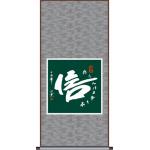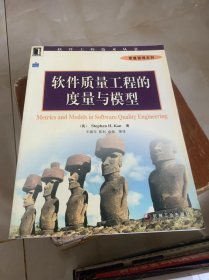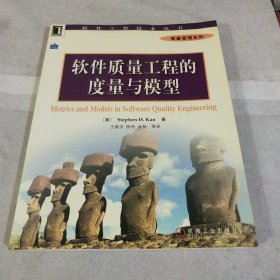
软件质量工程的度量与模型
正版现货 书内干净
¥ 10 2.0折 ¥ 49 九品
库存2件
北京昌平
认证卖家担保交易快速发货售后保障
作者卡恩
出版社清华大学出版社
出版时间2004-07
版次1
装帧平装
货号C12
上书时间2024-08-17
- 在售商品 暂无
- 平均发货时间 7小时
- 好评率 暂无
- 最新上架
商品详情
- 品相描述:九品
图书标准信息
- 作者 卡恩
- 出版社 清华大学出版社
- 出版时间 2004-07
- 版次 1
- ISBN 9787302088394
- 定价 49.00元
- 装帧 平装
- 开本 其他
- 纸张 胶版纸
- 页数 528页
- 【内容简介】
-
本书主要介绍了软件质量过程的度量与模型,内容包括质量规划、过程提高与质量控制、过程中(in-process)质量管理、产品工程(设计与代码复杂性)、可靠性评估与预测,以及用户满意度数据分析等。本书不仅阐述了有关软件质量的度量与技术知识,还给出了很多的实际案例分析,完全符合软件工程知识体(SWEBOK),具有很好的指导性和实用性。
本书可作为软件工程相关专业高年级学生和研究生的教材,同时也是软件工程专业人员的重要参考书。 - 【目录】
-
Foreword to the Second Edition
Foreword to the First Edition
Preface
Chapter 1:What Is Software Quality?
1.1 Quality:Popular Views
1.2 Quality:Professional Views
1.3 Software Quality
1.4 Total Quality Management
1.5 Summary
References
Chapter 2:Software Development Process Models
2.1 The Waterfall Development Model
2.2 The Prototyping Approach
2.3 The Spiral Model
2.4 The Iterative Development Process Model
2.5 The Object-Oriented Development Process
2.6 The Cleanroom Methodology
2.7 The Defect Prevention Process
2.8 Process Maturity Framework and Quality Standards
2.9 Summary
References
Chapter 3:Fundamentals of Measurement Theory
3.1 Definition,Operational Definition,and Measurement
3.2 Level of Measurement
3.3 Some Basic Measures
3.4 Reliability and Validity
3.5 Measurement Errors
3.6 Be Careful with Correlation
3.7 Criteria for Causality
3.8 Summary
References
Chapter 4:Software Quality Metrics Overview
4.1 Product Quality Metrics
4.2 In-Process Quality Metrics
4.3 Metrics for Software Maintenance
4.4 Examples of Metrics Programs
4.5 Collecting Software Engineering Data
4.6 Summary
References
Chapter 5:Applying the Seven Basic Quality Tools in Software Development
5.1 Ishikawa's Seven Basic Tools
5.2 Checklist
5.3 Pareto Diagram
5.4 Histogram
5.5 Run Charts
5.6 Scatter Diagram
5.7 Control Chart
5.8 Cause-and-Effect Diagram
5.9 Relations Diagram
5.10 Summary
References
Chapter 6:Defect Removal Effectiveness
6.1 Literature Review
6.2 A Closer Look at Defect Removal Effectiveness
6.3 Defect Removal Effectiveness and Quality Planning
6.4 Cost Effectiveness of Phase Defect Removal
6.5 Defect Removal Effectiveness and Process Maturity Level
6.6 Summary
References
Chapter 7:The Rayleigh Model
7.1 Reliability Models
7.2 The Rayleigh Model
7.3 Basic Assumptions
7.4 Implementation
7.5 Reliability and Predictive Validity
7.6 Summary
References
Chapter 8:Exponential Distribution and Reliability Growth Models
8.1 The Exponential Model
8.2 Reliability Growth Models
8.3 Model Assumptions
8.4 Criteria for Model Evaluation
8.5 Modeling Process
8.6 Test Compression Factor
8.7 Estimating the Distribution of Total Defects over Time
8.8 Summary
References
Chapter 9:Quality Management Models
9.1 The Rayleigh Model Framework
9.2 The Code Integration Pattern
9.3 The PTR Submodel
9.4 The PTR Arrival/Backlog Projection Model
9.5 Reliability Growth Models
9.6 Criteria for Model Evaluation
9.7 In-Process Metrics and Reports
9.8 Orthogonal Defect Classification
9.9 Summary
References
Chapter 10:In-Process Metrics for Software Testing
10.1 In-Process Metrics for Software Testing
10.2 In-Process Metrics and Quality Management
10.3 Possible Metrics for Acceptance Testing to Evaluate Vendor-Developed Software
10.4 How Do Your Know Your Product is Good Enough to Ship?
10.5 Summary
References
Chapter 11:Complexity Metrics and Models
11.1 Lines of Code
11.2 Halstead's Software Science
11.3 Cyclomatic Complexity
11.4 Syntactic Constructs
11.5 Structure Metrics
11.6 An Example of Module Design Metrics in Practice
11.7 Summary
References
Chapter 12:Metrics and Lessons Learned for Object-Oriented Projects
12.1 Object-Oriented Concepts and Constructs
12.2 Design and complexity Metrics
12.3 Productivity Metrics
12.4 Quality and Quality Management Metrics
12.5 Lessons Learned for OO Projects
12.6 Summary
References
Chapter 13:Availability Metrics
13.1 Definition and Measurements of System Availability
13.2 Reliability,Availability,and Defect Rate
13.3 Collecting Customer Outage Data for Quality Improvement
13.4 In-Process metrics for Outage and Availability
13.5 Summary
References
Chapter 14:Measuring and Analyzing Customer Satisfaction
14.1 Customer Satisfaction Surveys
14.2 Analyzing Satisfaction Data
14.3 Satisfaction with Company
14.4 How Good Is Good Enough?
14.5 Summary
References
Chapter 15:Conducting In-Process Quality Assessments
15.1 The Preparation Phase
15.2 The Evaluation Phase
15.3 The Summarization Phase
15.4 Recommendations and Risk Mitigation
15.5 Summary
References
Chapter 16:Conducting Software Project Assessments
16.1 Audit and Assessment
16.2 Software Process Maturity Assessment and Software Project Assessment
16.3 Software process Assessment Cycle
16.4 A Proposed Software Project Assessment Method
16.5 Summary
References
Chapter 17:Dos and Don'ts of Software Process Improvement
17.1 Measuring Process Maturity
17.2 Measuring Process Capability
17.3 Staged versus Continuous-Debating Religion
17.4 Measuring Levels Is Not Enough
17.5 Establishing the Alignment Principle
17.6 Take Time Getting Faster
17.7 Keep It Simple-or Face Decomplexification
17.8 Measuring the Value of Process Improvement
17.9 Measuring Process Adoption
17.10 Measuring Process Compliance
17.11 Celebrate The Journey,Not Just the Destination
17.12 Summary
References
Chapter 18:Using Function Point Metrics to Measure Software Process Improvement
18.1 Software Process Improvement Sequences
18.2 Process Improvement Economies
18.3 Measuring Process Improvements at Activity Levels
18.4 Summary
References
Chapter 19:Concluding Remarks
19.1 Data Quality Control
19.2 Getting Started with a Software Metrics Program
19.3 Software Quality Engineering Modeling
19.4 Statistical Process Control in Software Development
19.5 Measurement and the future
References
Appendix:A Project Assessment Questionnaire
Index
点击展开
点击收起
相关推荐
— 没有更多了 —



























以下为对购买帮助不大的评价